Semantic Representation of Balinese Traditional Dance
on
Jurnal Elektronik Ilmu Komputer Udayana
Volume 8, No 4. May 2020
p-ISSN: 2301-5373
e-ISSN: 2654-5101
Semantic Representation of Balinese Traditional Dance
Irianto Liko Koten a1, Cokorda Rai Adi Pramartha a2
aInformatics Department, Udayana University Bali, Indonesia
Abstract
Bali is an island in Indonesia that is rich in culture, an example of that culture is the traditional dance. The traditional dance performance is diverse from one village to another village in Bali. The traditional Balinese dance knowledge should be captured dan documented well in a digital form so that it can be shared easily to different people and generations across the world. The use of ontology as an information representation technique is the preferred solution in this matter because ontology can be used to enhance the development of semantic applications, especially when dealing with semantic webs. In this project, the ontology was built using the Protege ontology development tool. We follow the methontology ontology development method where this methodology clearly describes each of its activities. In this study, we focus to describe variants of Balinese traditional dance. In the future, we expect that more types of dance can be documented using our proposed ontology.
Keywords: Balinese Dance, Ontology,Semantic Web
Bali is one of the islands in Indonesia and has many internationally recognized panoramas. Besides that, it turns out that Bali has a myriad of cultural wealth, including traditional Balinese dances. The diversity of information regarding the various types of dance in Bali must be well described. The use of ontology as an information representation technique is the choice of the solution in this problem. Ontology on the semantic web is a catalog where the scheme uses ontology. Ontology is needed to enhance the development of semantic applications, especially on the company's semantic web, which consists of the application of semantic technology in a corporate environment. In the preparation of this ontology, it will be built using the methontology method, methontology is one of the methodologies of developing an ontology model, where this methodology has advantages related to the description of each activity that must be carried out in detail. In addition, methontology also has the ability that the built ontology can be reused for further system development. Therefore, a study is proposed to build an ontology model that represents the domain of knowledge about dance in Bali. This research is expected to be able to build ontology models that have good design quality by utilizing the methontology methodology so that it can be further implemented in the semantic web model.
Ontology is a way to represent the knowledge of a set of concepts in an information domain and the relationship between those concepts, so that ontology can be used to present information semantically also to organize and map a collection of information resources in a systematic and structured manner. This is very useful in terms of data interoperability because it can be done more effectively and efficiently [3]. There are several benefits in using the ontology, such as being able to explain a domain of knowledge explicitly, providing a hierarchical structure of concepts to explain a domain and how they related. In order to share an understanding of structured information and reuse the domain of knowledge, for example, we want to build a broad ontology, we can develop an existing ontology and integrate it with several other
ontologies that are relevant to the ontology to be built [1-4] .
The semantic web is an approach that was developed specifically on web technology. Semantic Web and Semantic Web technologies provide us with a new approach to managing information and process, as a creation and the use of semantic metadata. As information, metadata divided into two levels. First, explaining documents, for example, web pages or parts of documents, such as paragraphs. On the other hand, describing the entity in the document, for example, a person or company. However, what is important is that the metadata is semantic, which provides knowledge about the contents of the document (eg the subject, or relationships with other documents) or about the entities in the document [1] .
The method being used in this study is the methontology method as a methodology of Building Ontologies from the Beginning In general, this methodology gives us a set of guidelines on how to do
activities identified the ontology development process, types of techniques that are most appropriated in each activity and products being produced individually [5]. it can be said that this method is one of the methodologies of development ontology model, where this methodology has advantages related to the description of each activity that must be carried out in detail.
Protege software was developed by the Stanford Center for Biomedical Informatics Research at the Stanford University School of Medicine. Protege software is an open source under license called Mozilla Public License (MPL). Protege software is a tool to help ontology developers to develop systems based on the Knowledge Base called System knowledge base. Protege can create, edit and save ontologies in CLIPS, RDF, XML, UML and Relational Database formats. In general, protégé makes it easy for users to make basic modeling in a simpler way that is complemented by visualization of SubClass relationships in Tree map [6] .
SPARQL Query is a query language for RDF. RDF Graph is composed of scripts which are formed from Subjects, Predicates and Objects. RDF can be defined in RDF Concepts and Abstract Concept Syntax. This triple can come from a variety of sources. In instance can be obtained directly from the RDF document, can be stored in the RDF script standard. RDF expressions can be stored in other formats such as XML and Relational Database. SPARQL is a query language for getting information from RDF Graph. which provides facilities such as extracting information in the form of URIs, Blank Nodes and Literals, extracting RDF Subgraphs and constructing new RDF Graphs based on query graphs [6] .
The purpose of the speciation phase is to produce informal, semi-formal or formal ontology speciation documents written in natural language, each using a set of intermediate representations or using competency questions.
a. b. c. d. e.
f.
g. h.
Domain
: Balinese Traditional Dancing Classification
: May 26th , 2019
: Irianto Liko Koten
: Irianto Liko Koten
: Building an ontology model to facilitate the Balinese
Date
Conceptualized-by
Implemented by Objective
Traditional Dancing Classification
Level of Formality : Semi-formal
Scope : Balinese Traditional Dancing Classification
Knowledge Sources : Books, journals, internet
Knowledge acquisition is an independent activity in the process of developing ontology. The analysis of informal texts by studying the main concepts given by books and study handbooks. Formal text analysis. The first thing to do is to identify the structure that will be detected (definition, affirmation, etc.) and the type of knowledge contributed by each (concepts, attributes, values, and relationships).
Building a list of terms that include concepts, instances, verbs, and properties. So the glossary identifies and collects all useful and potentially usable domain knowledge then being implemented in the form of classes and sub-classes as shown in Figure 1.
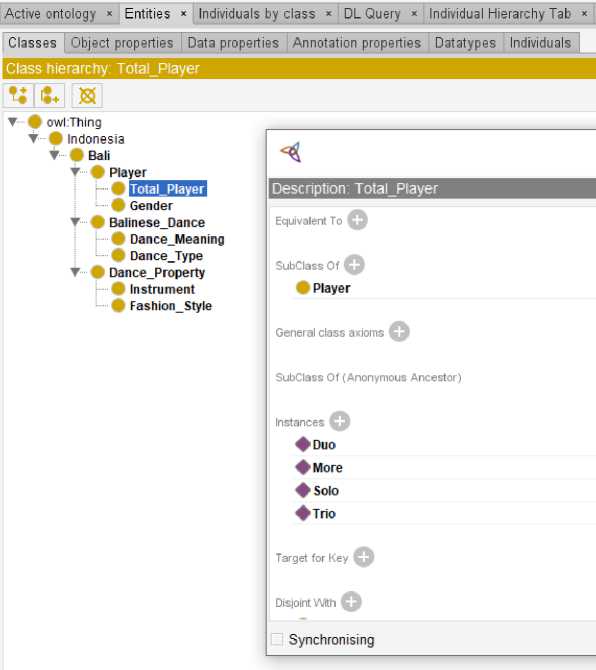
Figure 1. Class Hierarchy and Total Player class instances
Considering the reuse of definitions that have been built into ontology, or in other words, reexamine the use of the language so that errors do not occur in determining relations.
In its implementation, the authors used software Protege 5.5.0 Build Beta-9. in this implementation can be seen some data that has been formed such as data object properties in Figure 2, data properties in Figure 3 as well as the individuals and their relationships in Figure 4.
In Figure 2, 3 properties objects are created for example, where domain (Dance_Type) is the

type or name of dance as well as a subject and then the property object (have_meaning) as a predicate and Dance_Meaning as the object.
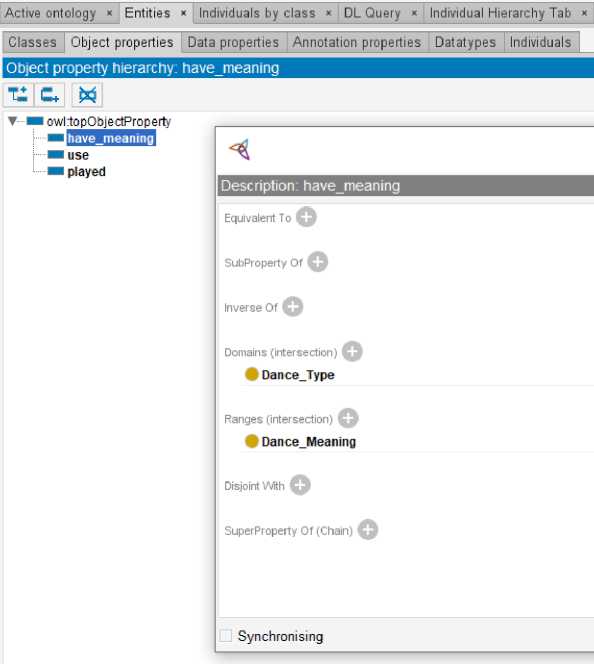
Figure 2. Object Properties
In Figure 3, three data properties are made for example, wherein the image player gender which is the gender of the dancers from the Gender class domain with the type of string data.
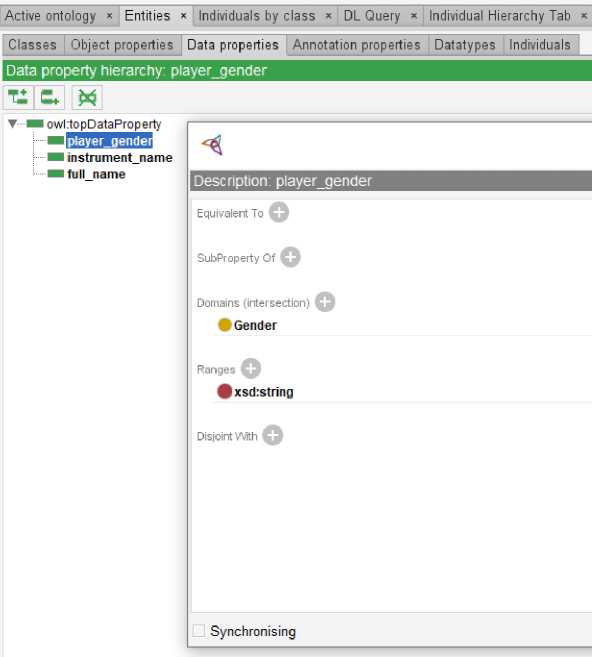
Figure 3. Data Properties
Adding individuals, as in Figure 4 where the individual samples used as examples such as Tari_Pendet with Dance_Type from class domains that have Player “more” means more than one player, have_meaning “Pemujaan” or have a dance function as a worship, using “Gelang” or one of the clothing attributes being used is the bracelets etc.
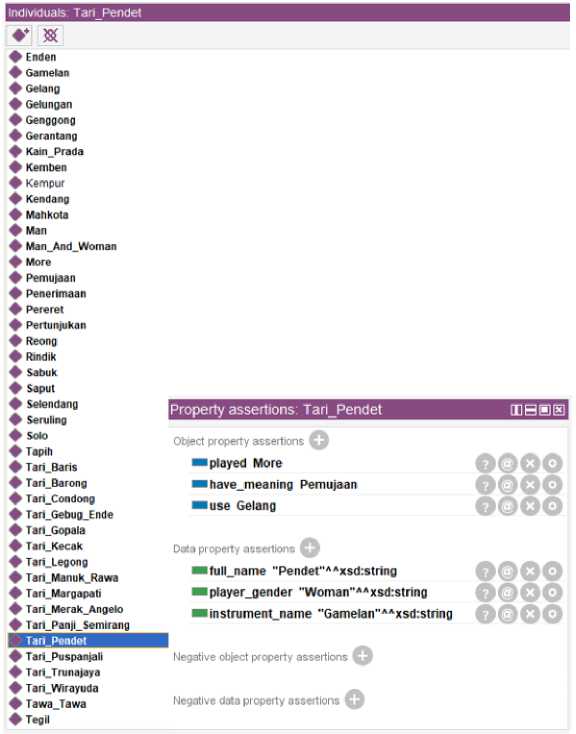
Figure 4. Individual Entities and examples of their relationships
At this stage, the evaluation process is carried out by querying the software or application protege 5.5.0 Build Beta-9 where the results are given at the beginning of the execution to see the alignment of the subject and object created as shown in Figures 5 and 6 below.
In Figure 5, executing the query with the command to find the type of dance that uses all the equipment in this case (Fashion_Style) is a “Bunga” where Object signifies all relations of "use", where "use" itself is an object property as well as a relation that connects domain classes with domain (Dance_Property) classes.
PREFlXunl: <http://www.semanticweD.org/user/ontologles/2019f7/untltled-ontology-8ff>
SELECT * {?Dance_Type uni:use uni:Bunga}
Dance_Type
Tari-Manuk-Rawa
TarLGopaIa
Execute
Figure 5. SPARQL Query 1 execution results
In Figure 6, executing the request with the command to find the purpose of the dance, which must display the dance intended to show “Pertunjukan”.
PREFIXuni: <http://www.semanticweb.Org/user/ontologies/2019/7/untitled-ontology-8ff>
SELECT * {?Dance_Type uni:have_meaning uni:Pertunjukan}
Dance_Type
TarLWirayuda TarLKecak TarLMerak-AngeIo TarLManuk-Rawa Tari-Gopala
Execute
Figure 6. SPARQL Query 2 execution results
Some documentation results from this research are OntoGraf from 15 traditional dance samples data and 5 data samples named Tari_Wirayuda, Tari_Kecak, Tari_Merak_Angelo, Tari_Manuk_Rawa, and Tari_Gopala with the aim of veneration "Pertujukan" as well as the direction of the class attributes that have been built and linked as shown in Figure 7 below.
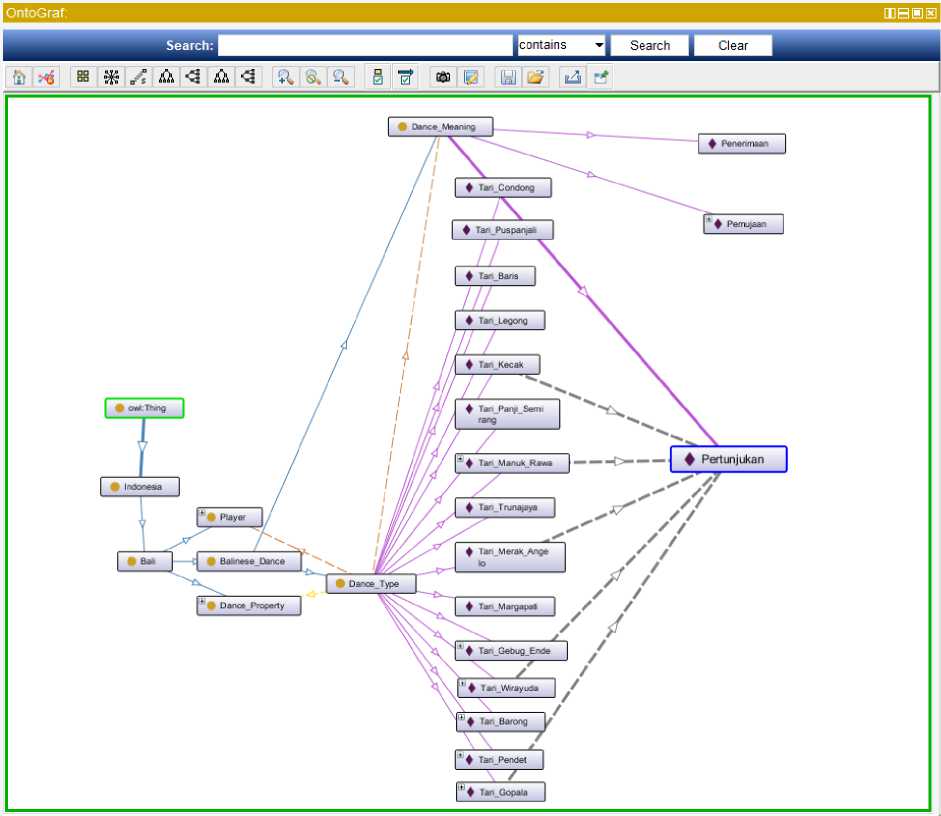
Figure 7. Ontograf
Ontology classification of traditional dance in Bali which was built with software Protege 5.5.0 Build Beta-9 produced 11 classes, 3 object properties and 3 property data and 54 individuals. In the research above shows that the application of ontology in the case of classifying traditional dance types in bali, able to provide information well and in accordance with user requests and can represent the knowledge of a set of concepts in an information domain and the relationship between these concepts, so that the presentation of information can be done in a semantics where the mapping of information resources collection becomes systematic and structured. In the future, this research will work on the quality of ontology, especially in the classification of traditional dances because the data that continuously develop makes this research interesting to develop. Considering that ontology can also be developed from existing ontologies and integrated with several other relevant ontologies into the ontology to be developed that can be implemented into a semantic web-based system.
References
-
[1] C. R. A. Pramartha, “Assembly the Semantic Cultural Heritage Knowledge,” Jurnal Ilmu
Komputer, vol. 11, no. 2, pp. 83-95, 2018.
-
[2] C. Pramartha, J. G. Davis, and K. K. Y. Kuan, "A Semantically-Enriched Digital Portal
for the Digital Preservation of Cultural Heritage with Community Participation," Digital Heritage. Progress in Cultural Heritage: Documentation, Preservation, and Protection: 7th International Conference, EuroMed 2018, Nicosia, Cyprus, October 29 – November 3, 2018, Proceedings: Springer International Publishing, 2018.
-
[3] C. Pramartha, J. G. Davis, and K. K. Y. Kuan, "Digital Preservation of Cultural Heritage:
An Ontology-Based Approach." pp. 1-12, 2017.
-
[4] V. Lombardo, A. Pizzo, and R. Damiano, “Safeguarding and Accessing Drama as
Intangible Cultural Heritage,” J. Comput. Cult. Herit., vol. 9, no. 1, pp. 1-26, 2016.
-
[5] M. Fernández-López, A. Gómez-Pérez, and N. Juristo, “Methontology: from ontological
art towards ontological engineering,” 1997.
-
[6] B. DuCharme, Learning SPARQL: O'Reilly Media, 2013.
419
Discussion and feedback